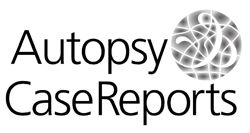Necrotizing fasciitis and fatal septic shock associated with Streptococcus constellatus
Fareed Rajack; Shawn Medford; Tammey Naab
Abstract
Keywords
References
1 Tymon-Rosario J, Atrio JM, Yoon HA, Erlichman D, Lerner V.
2 Jiang S, Li M, Fu T, Shan F, Jiang L, Shao Z. Clinical characteristics of infections caused by
3 Asam D, Spellerberg B. Molecular pathogenicity of
4 Reißmann S, Friedrichs C, Rajkumari R, et al. Contribution of
5 Ng KW, Mukhopadhyay A.
6 Bert F, Bariou-Lancelin M, Lambert-Zechovsky N. Clinical significance of bacteremia involving the “
7 Jacobs JA, Pietersen HG, Stobberingh EE, Soeters PB. Bacteremia involving the “
8 Issa E, Salloum T, Tokajian S. From Normal flora to brain abscesses: a review of
9 Whiley RA, Beighton D, Winstanley TG, Fraser HY, Hardie JM. Streptococcus intermedius,
10 Kanamori S, Kusano N, Shinzato T, Saito A. The role of the capsule of the
11 Budziaszek J, Pilarczyk-Zurek M, Sitkiewicz I, Koziel J. The corruption of innate immunity by
12 Olson AB, Kent H, Sibley CD, et al. Phylogenetic relationship and virulence inference of
13 Chew TA, Smith JM. Detection of diacetyl (caramel odor) in presumptive identification of the “
14 Davoudian P, Flint NJ. Necrotizing fasciitis. Contin Educ Anaesth Crit Care Pain. 2012;12(5):245-50.
15 Freischlag JA, Ajalat G, Busuttill RW. Treatment of necrotizing soft tissue infections: the need for a new approach. Am J Surg. 1985;149(6):751-5.
16 Sarani B, Strong M, Pascual J, Schwab CW. Necrotizing fasciitis: current concepts and review of the literature. J Am Coll Surg. 2009;208(2):279-88.
17 Thulin P, Johansson L, Low DE, et al. Viable group A
18 Reid SD, Chaussee MS, Doern CD, et al. Inactivation of the group A
19 Vayvada H, Demirdover C, Menderes A, Karaca C. Necrotizing fasciitis: diagnosis treatment and review of the literature. Ulus Travma Acil Cerrahi Derg. 2012;18(6):507-13.
20 Swain RA, Hatcher JC, Azadian BS, Soni N, De Souza B. A five-year review of necrotising fasciitis in a tertiary referral unit. Ann R Coll Surg Engl. 2013;95(1):57-60.
21 Anaya DA, McMahon K, Nathens AB, Sullivan SR, Foy H, Bulger E. Predictors of mortality and limb loss in necrotizing soft tissue infections. Arch Surg. 2005;140(2):151-7.
22 Long B. Emergent management of necrotizing soft-tissue infections [Internet]. Medscape; 2019 [cited 2023 Sept 26]. Available from:
23 Schulz S. Necrotizing fasciitis: background, pathophysiology, etiology [Internet]. Medscape; 2019 [cited 2023 Sept 26]. Available from:
24 Wong CH, Khin LW, Heng KS, Tan KC, Low CO. The LRINEC (Laboratory Risk Indicator for Necrotizing Fasciitis) score: a tool for distinguishing necrotizing fasciitis from other soft tissue infections. Crit Care Med. 2004;32(7):1535-41.
25 Sandner A, Moritz S, Unverzagt S, Plontke SK, Metz D. Cervical necrotizing fasciitis: the value of the laboratory risk indicator for necrotizing fasciitis score as an indicative parameter. J Oral Maxillofac Surg. 2015;73(12):2319-33.
26 Wronski M, Slodkowski M, Cebulski W, Karkocha D, Krasnodebski IW. Necrotizing fasciitis: early sonographic diagnosis. J Clin Ultrasound. 2011;39(4):236-9.
27 Ramirez-Schrempp D, Dorfman DH, Baker WE, Liteplo AS. Ultrasound soft-tissue applications in the pediatric emergency department: to drain or not to drain? Pediatr Emerg Care. 2009;25(1):44-8.
28 Hakkarainen TW, Kopari NM, Pham TN, Evans HL. Necrotizing soft tissue infections: review and current concepts in treatment, systems of care, and outcomes. Curr Probl Surg. 2014;51(8):344-62.
29 Bakleh M, Wold LE, Mandrekar JN, Harmsen WS, Dimashkieh HH, Baddour LM. Correlation of histopathologic findings with clinical outcome in necrotizing fasciitis. Clin Infect Dis. 2005;40(3):410-4.
30 Wang YS, Wong CH, Tay YK. Staging of necrotizing fasciitis based on the evolving cutaneous features. Int J Dermatol. 2007;46(10):1036-41.
31 McHenry CR, Piotrowski JJ, Petrinic D, Malangoni MA. Determinants of mortality for necrotizing soft-tissue infections. Ann Surg. 1995;221(5):558-65.
32 Wong CH, Chang HC, Pasupathy S, Khin LW, Tan JL, Low CO. Necrotizing fasciitis: clinical presentation, microbiology, and determinants of mortality. J Bone Joint Surg Am. 2003;85(8):1454-60.
33 Mok MY, Wong SY, Chan TM, Tang WM, Wong WS, Lau CS. Necrotizing fasciitis in rheumatic diseases. Lupus. 2006;15(6):380-3.
34 Bilton BD, Zibari GB, McMillan RW, Aultman DF, Dunn G, McDonald JC. Aggressive surgical management of necrotizing fasciitis serves to decrease mortality: a retrospective study. Am Surg. 1998;64(5):397-400. PMid:9585771.
35 Hammond KL. Practical issues in the surgical care of the obese patient. Ochsner J. 2013;13(2):224-7. PMid:23789009.
36 Royal Australasian College of Surgeons. Lessons from the Audit. Brisbane: RACS; 2014. (vol. 13).
37 Pierpont YN, Dinh TP, Salas RE, et al. Obesity and surgical wound healing: a current review. ISRN Obes. 2014;2014:638936.
Submitted date:
09/26/2023
Accepted date:
12/14/2023
Publication date:
01/08/2024

